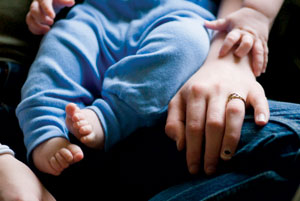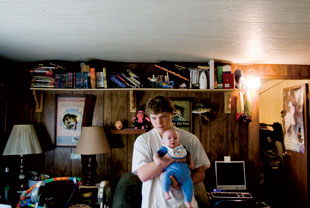COLUMBIA FALLS – When she learned she was pregnant, 17-year-old Leesa Dougherty was just as surprised as everyone else.
A cross-country runner for Columbia Falls High School, Dougherty had broken her ankle and was hobbling around on crutches. She thought she’d gained a little weight, but nothing to be too concerned about.
Then a pregnancy test came back positive, and she confirmed it with her doctor.
“I didn’t believe it since I didn’t show,” Leesa, now a junior in high school, said. “They thought I was three, four months along. I was seven.”
 |
|
Five-month-old Karson sits on his mother, Leesa Dougherty’s, lap in the living room of their Columbia Falls home. |
As she relates the story in their living room, her five-month-old son Karson, a happy baby with curious eyes, again spits up on his dad, Leesa’s husband, Nathan Dougherty, 18.
Karson appears pleased with himself, and the couple jokes about it to each other as they begin what looks to be a very familiar procedure to clean up the mess.
Like a lot of girls her age, Leesa says she watches shows on television showcasing teen pregnancy, such as MTV’s “Teen Mom” and “16 and Pregnant.” But she doesn’t think they tell the whole story.
Karson was born nine weeks premature, which led to a host of physical troubles and stress on his young parents. There’s also financial pressure, which Nathan hopes to relieve by joining the Army after he graduates.
“Most of the shows that I watch, they don’t have troubles like this,” Leesa said.
While the couple’s story is their own, Leesa is hardly alone as a young woman becoming pregnant before her 20th birthday in the Flathead.
In 2007, Flathead County experienced an increase in teen pregnancies, and it has continued to be one of the highest areas of teen pregnancy in Montana over the following years. May is National Teen Pregnancy Prevention Month, and local health officials are working to reverse the trend in the valley through education and parental involvement.
STATISTICALLY SPEAKING
From 2007 to 2009, the most recent data available from the state Department of Public Health and Human Services, Montana saw 4,883 teen pregnancies. That number is a slight decrease from the 2004-2006 period, which settled at 4,890.
But in Flathead County, the numbers are rising. From 2004-2006, 404 teens became pregnant in the county. In the following three-year time period, the number increased to 481.
“We in the Flathead saw a fairly significant spike,” Holly Jordt, a registered nurse with the Flathead City-County Health Department, said. “We just haven’t made that downward turn again.”
The state’s average rate of teen pregnancy per thousand people is 48.8. Flathead County’s teens are becoming pregnant at a rate of 57.1 per thousand people.
The county’s rate is slightly higher than Yellowstone County, where despite having the highest number of actual teen pregnancies from 2007-2009, at 766, its pregnancy rate is 57 per thousand people.
Big Horn, Blaine, Glacier, Hill, Lake and Roosevelt counties all have higher pregnancy rates than Flathead County, but Flathead ranked second highest in the state as far as the actual number of pregnant teens from 2007-2009.
EARLY GRADUATION
Seventeen-year-old Elizabeth Chattin saw the value in graduating early. She finished at Glacier High School in January, just in time to take care of her son Jeremiah, who arrived three weeks earlier than his March 7 due date.
Chattin moved from California to Kalispell for her senior year of high school and to live with her mother. She didn’t know it then, but Chattin was already pregnant when she touched down in Montana.
“That’s scary, I’m like halfway around the world,” Chattin remembers thinking. “I told him, the dad, about it and he just got upset. He broke up with me.”
Only 16 at the time, Chattin found support from her mother and her mother’s friends. She also went to support groups, including the Teen MOPS program and the Hope Pregnancy Center.
Of all the thoughts rushing through her head, Chattin said she was certain about one thing: she would keep the baby.
“I didn’t put him up for adoption. I didn’t feel like that was right because I was the one who chose to have sex,” Chattin said, adding that she felt the same way about abortion.
As far as sex education in California, Elizabeth has memories of warnings against sexually transmitted diseases (STDs) and little else.
“I had a health class when I was in ninth grade and they talked about STDs, but I don’t recall them ever really talking about pregnancy,” Elizabeth said. “I didn’t really think it would happen to me, but I guess like most teenagers, we never really think bad things are going to happen to us.”
THE BIRDS & THE BEES
In the Flathead, Jordt said sex education is a combined effort between the public schools and the health department. She and other family planning advisors begin talking with kids about puberty when they hit fourth, fifth and sixth grades.
Grades seven and up receive tailored messages on communication in relationships, and then proceed to learning about STDs, HIV, pregnancy, contraception and condoms.
Sex education entered the spotlight in Montana last year, when vocal opponents criticized the proposed Helena schools curriculum as “too much too soon,” according to the Associated Press.
That controversy helped spur House Bill 456, which passed the Legislature this year and would have mandated written parental permission before a child could take sex education and would have prevented teachers from using materials by organizations that provide abortions. Gov. Brian Schweitzer vetoed the bill.
While the battle continues over how and if sex education should be taught, the number of teens having sex remains static. In 1995, 32.2 percent of Montana high school students reported to the state’s Youth Risk Behavior Survey that they were sexually active. The percentage was exactly the same in 2009.
As a nurse speaking with teenagers on a regular basis, Jordt said she understands some parents’ reluctance to have someone else talk to their children about sex. She also understands that some parents are good at talking to their kids, while others are not.
However, she noted that teens who receive comprehensive sex education – hearing messages about the different aspects of sex from their parents, school and religious groups – are the least likely to acquire STDs or become pregnant.
“What we know statistically, is that kids who have had comprehensive sex education, learned about abstinence as well as other birth control methods and condoms, are the kids who are delaying sexual activity,” Jordt said, citing a study by the Centers for Disease Control and Prevention.
And while the discussion can be awkward for many parents, Jordt said most of the teens she counsels want to hear the information from their parents.
“Our hope is that parents figure out how to have those conversations even though they’re really uncomfortable,” Jordt said, adding that the health department has resources available to help.
REALITY v. REALITY TV
As teenagers, the young parents interviewed for this story said they felt they had enough information about sex, but they should have taken more time to think about the consequences of their choices.
Maranda Matson, now 21, had her first child, Eryn, when she was 15. She lives in Kila with family members, and is trying to regain custody of Eryn and Dannyele, 1. She’s also trying to finish her high school education after dropping out her sophomore year when she became pregnant.
She advised teenagers to think carefully about their actions, because the price for their choices can be very high.
 |
|
Nathan Dougherty holds his 5-month-old son, Karson, in the living room of their Columbia Falls home. Nathan is headed to basic training for the Army after high school. |
“I love the fact that I have my kids, but being so young when you have them, it made my life a lot harder than it needs to be,” Maranda said. “It would just be better if a lot of people would wait until they have an education and they have themselves financially set and they’re actually ready to have a kid.”
Elizabeth Chattin offered similar advice, noting that television’s idea of teen parenthood is more about entertainment and drama than accuracy.
“Watch what you’re doing because it does happen. Even if you use protection, stuff happens,” Chattin said. “It’s not easy. They have shows on MTV, and it kind of glamorizes what being a mom is. They don’t really show when the baby doesn’t stop crying or all the diapers you need to change.”
Chattin reports that she’s happy now, but it was a struggle to get here. She said teenagers should discuss the repercussions of sex before having it, because the reality is much tougher than she anticipated.
“It happens and it’s not just on TV,” she said. “It happens in real life; it happens all over.”
TEEN PREGNANCY STATS
From 2004 through 2006:
Number of Teen Pregnancies in MT: 4,890
Rate per thousand people: 48.9
Number of Teen Pregnancies in Flathead County: 404
Rate per thousand people: 48.8
From 2007 through 2009:
Number of Teen Pregnancies in MT: 4883
Rate per thousand people: 48.8
Number of Teen Pregnancies in Flathead County: 481
Rate per thousand people: 57.1